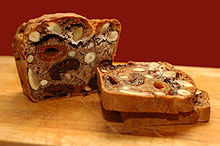Bread with fruits
Fruit bread (also Berewecke, pear bread , Hutzenbrot , Hutzelbrot , fruit bread , Schnitzbrot or tents ) is a sweet, dark bread with eingebackenem dried fruit .
It is usually formed into small, elongated loaves . The bread has a moist, firm dough and pieces of fruit and nuts are visible when cut . It is often decorated with white almonds and cherries . It is very durable.
Emergence
In southern Germany , Austria as well as South Tyrol and Trentino , bread was refined with dried pears , especially during Advent . Depending on the dialect, these pear slices were called Hutzeln , Hutzen ( Alemannic ) or Kletzen ( Bavarian- Austrian) and thus the bread was also called Hutzenbrot or Kletzenbrot . Due to growing prosperity or the import of tropical fruits , more dried fruits such as plums , raisins , apricots , dates , figs , orange peel and lemon peel made their way onto the list of ingredients . At first, fruit bread was made without honey , cane sugar or beet sugar ; the sweetness came from the dried pears alone. The variant of a fruit bread wrapped in yeast dough is rather rare . The yeast dough takes away the rustic look of the bread , but prevents the fruits on the outside from burning .
In the upper Allgäu, which was very poor because of its barren soil, “pear bread” was eaten on Christmas Eve after returning from Christmas mass. There was also a glass of “Obstler” - a high-proof, aromatic schnapps made from apples and pears. The children of poor people sang Advent and Christmas carols in front of the houses of wealthy farmers and received the "Singâte" (emphasis on i, cf. singing), as the pear bread was called, as a thank you. Today hardly anyone knows this expression.
regional customs
We started with the baking of the fruit bread in the days around St. Andrea's Day on November 30th. On St. Andrew's Night , the " Klöpfelnächte " ( kneading nights ) began, a fertility custom in which masked young men begged with poems for gifts, including fruit bread.
Together with other autumn gifts, it was part of the festive dishes on St. Nicholas Day .
On Christmas Eve or on St. Stephen 's Day, the house father cut and distributed the fruit bread. The children, servants and maids received a share. To bring good luck to the stable, the animals were given fruit bread as a " mouthful ".
An old engagement custom is cutting fruit bread. The end pieces of the fruit bread were given away to their lovers by the women of marriageable age, in order to signal their affection with smooth cut edges or to end the relationship with rough cut edges.
In the literature
Eduard Mörike (1804–1875) dedicated a story to the Hutzeln about the "Stuttgarter Hutzelmännlein":
In his novel “The Magic Mountain”, Thomas Mann refers to pear bread as a specialty of the Kurhaus in Monstein. In the chapter "The great irritability" he writes: "The day trippers ordered a snack from the landlady willing to serve: coffee, honey, white bread and pear bread, the specialty of the place."
Many children are familiar with fruit bread from the popular children's book “ The Very Hungry Caterpillar ”.
Web links
- Article about Kletzenbrot on the portal Customs pages .
- Article and recipe in the SalzburgerLand magazine
- Kletzenbrot . Entry no. 172 in the register of traditional foods of the Austrian Federal Ministry for Agriculture, Regions and Tourism .
Individual evidence
- ↑ Hella Kemper: More, more, more! online for TIME.


